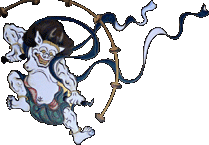 |
|
|||||||
|
Kyoto - The Cultural Centre of Japan - Kyoto, with its hundreds of temples and gardens, was the imperial capital between 794 and 1868, and remains the cultural centre of Japan. Its raked pebble gardens, sensuously contoured temple roofs and mysterious Shinto shrines fulfill the Japanese fantasy of every Western cliche hunter. With an astonishing 1,600 Buddhist temples, 400 Shinto shrines, a trio of palaces, and dozens of gardens and museums, Kyoto is Japan's cultural treasure house. Seventeen of Kyoto's ancient structures and gardens have been declared UNESCO World Heritage sites. (from www.lonelyplanet.com) Culture Kyoto is considered the cultural center of Japan. During World War II when firebombing was conducted throughout the country, Kyoto and its 1600 Buddhist temples, 400 Shinto shrines, palaces, gardens and architecture were spared, leaving it one of the best preserved cities in Japan. Therefore, it says that they are housing some 20% of Japan's National Treasures. Kyoto area has some of the most famous Buddhist temples, Shinto shrines including:
Other notable sites in and around Kyoto include Arashiyama and its picturesque lake, the Gion and Pontocho geisha quarters, the Philosopher's Walk, and the canals which line some of the older streets. The "Historic Monuments of Ancient Kyoto" are listed by the UNESCO as a World Heritage Site. These include Kamigamo Shrine, Shimogamo Shrine, Kyo-o-gokoku-ji (To-ji), Kiyomizu-dera, Daigo-ji, Ninna-ji, Byodo-in, Ujigami-jinja, Kozan-ji, Saiho-ji (Koke-dera), Tenryu-ji, Rokuon-ji (Kinkaku-ji), Jisho-ji (Ginkaku-ji), Ryoan-ji, Hongan-ji, and Nijo-jo (Nijo Castle). Climate & Weather Japan is a country that takes great pride in the beauty of it's 4 seasons, and the different flora and fauna that spring up are the basis of Japanese aesthetics. Autumn in Kyoto is clear and comfortable. Average temperature in November is around 13 Celsius (55F). The temperature difference between day and night is large, so we recommend you to put on warm clothes (lightweight jackets & sweaters) during nighttime. You can check the 5 day forecast of Kyoto at CNN.com. Visa For entering Japan, you need a valid passport and in some cases a visa. To check whether you need a visa, and how to apply it, visit the homepage of the Ministry of Foreign Affairs (http://www.mofa.go.jp/j_info/visit/visa/). Obtaining a visa may take a long period of time, a few months in some cases, so please apply immediately if you need a visa. Ask Japanese Embassies/Consulates or local travel agencies for necessary documents. Links |
||||||||
| [ TOP | Tentative Programs (PDF) | Flyers | ] | ||||||||
| Copyright © 2006 Kyoto University |  |
|||||||